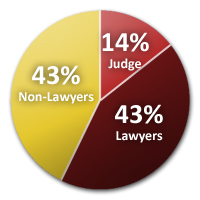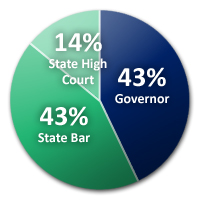Authors: Alfred A. Lindseth and Eric A. Hanushek
| State High Court & Judicial Nominating Commission | Composition & Terms of Judicial Nominating Commission | Judicial Selection Process | Legal Authority |
|---|---|---|---|
Terms: 6 years (staggered, except for the Chair) |
General
Interim Vacancies
|

Percentage of Lawyers on the Nominating Commission

Who Selects the Nominating Commissioners?
Latest News
- Supreme+Court+asked+to+strike+down+allegedly+unconstitutional+Lake+of+the+Ozarks+business+districts - Missouri Lawyers Media
- Five new graduates join ranks of Missouri State Highway Patrol - kttn
- Missouri+Supreme+Court+celebrates+investiture+of+Judge+Broniec - Missouri Lawyers Media
- Supreme Court revives Mo. officer's gender discrimination case, setting new precedent for forced transfers - Police News
- Messenger: Ballwin pitching lesson fight strikes a nerve. Who doesn't have an HOA story? - St. Louis Post-Dispatch
- Missouri Supreme Court welcomes Judge Kelly Broniec, marking female majority - ktvo.com
- Formal ceremony held for Missouri Supreme Court Judge Kelly Broniec - Missourinet.com
- Missouri abortion rights campaign raises nearly $5 million ahead of signature deadline - Kansas City Star
- Missouri Attorneys General are prolific censors posing as free speech champions • Missouri Independent - Missouri Independent
- MO Supreme Court sets execution date for man, second lethal injection scheduled this year - Kansas City Star
Scholarship & White Papers
Public Opinion Research
-
Proposals to Amend the Judicial Appointment Process
St. Louis Lawyers Chapter, 27 April 2007 – Event Audio
Featuring: Douglas Copeland, William G. Eckhardt, William J. Placke, Jo Mannies
-
Debating the Role of the Chief Justice in Judicial Selection
St. Louis Lawyers Chapter, 11 March 2008 – Event Audio
Featuring: William Placke, Woody Cozad, Tom Walsh, Randy Scherr, Samuel Hais
-
Two Perspectives on Missouri’s Non Partisan Court Plan
Kansas City Lawyers Chapter, 14 November 2007 – Event Video
Featuring: David Oliver, William Placke
Media & Commentary
-
Declining to Follow Its Neighbor Missouri, the Kansas Supreme Court Holds Noneconomic Damages Cap in Medical Malpractice Cases Constitutional
The Kansas Supreme Court, in Miller v. Johnson,1 recently upheld Kansas’ statutory cap on non-economic damages in personal injury cases, including medical malpractice cases, as constitutional. Specifically, the Kansas Supreme Court held the cap, set forth in K.S.A. 60-19a02, does not violate Sections 5 and 18 of the Kansas Constitution Bill of Rights providing a right to a jury trial and a right to damages, respectively. This decision is in contrast to its neighboring state’s supreme court, which recently declared a statutory cap on non-economic damages in medical malpractice cases unconstitutional for violation of the right to a jury trial.2
-
Missouri Supreme Court Overrules 20 Years of Precedent in Holding Noneconomic Damages Cap Unconstitutional
Overruling its own twenty-year precedent in Adams By and Through Adams v. Children’s Mercy Hospital1 (Adams), the Missouri Supreme Court, in a four-to-three decision, held in Watts v. Lester E. Cox Medical Centers (Watts) that the cap on non-economic damages in medical malpractice cases in Mo. Rev. Stat. § 538.210, passed as part of the comprehensive tort reform passed by the Missouri Legislature in 2005, violates article I, section 22(a) of the Missouri Constitution’s right to trial by jury.2 The Missouri Supreme Court also held that Mo. Rev. Stat. § 538.220 grants a trial judge authority to determine the manner by which future damages shall be paid, including what amount shall be paid in future installments.3


 Supreme Court of Missouri
Supreme Court of Missouri